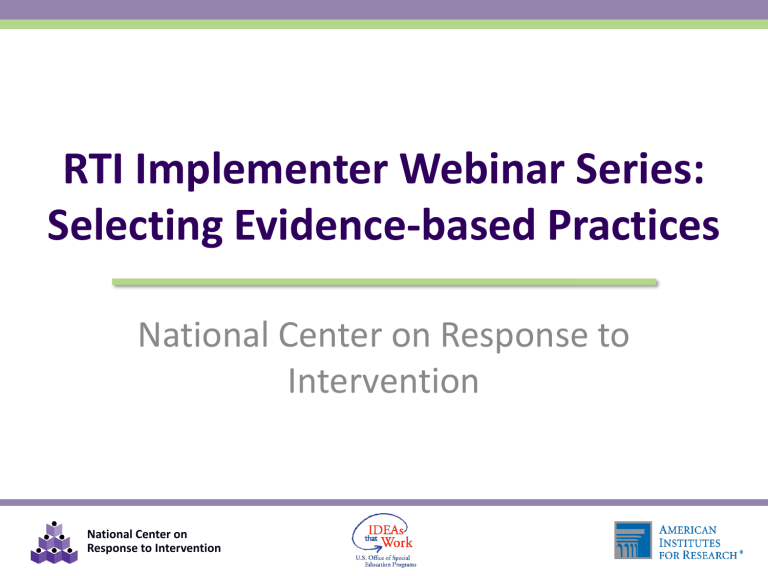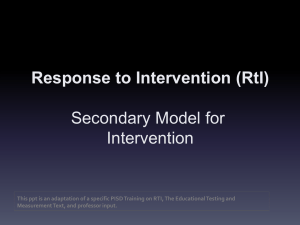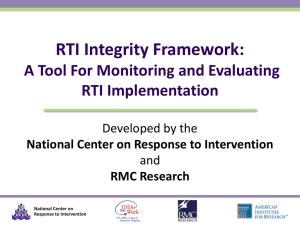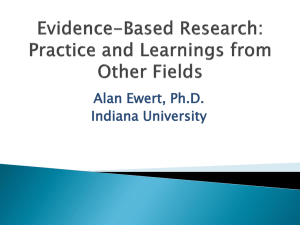PowerPoint Slides - Center on Response to Intervention

RTI Implementer Webinar Series:
Selecting Evidence-based Practices
National Center on Response to
Intervention
National Center on
Response to Intervention
RTI Implementer Series Overview
Introduction Screening
Defining the
Essential
Components
Assessment and
Data-based
Decision Making
Establishing
Processes
What Is RTI?
What Is
Screening?
Understanding
Types of
Assessment within an RTI Framework
Using
Screening Data for Decision
Making
Implementing RTI Establishing a
Screening
Process
Progress
Monitoring
What Is Progress
Monitoring?
Using Progress
Monitoring Data for Decision
Making
Multi-level
Prevention
System
What Is a Multilevel Prevention
System?
IDEA and Multilevel Prevention
System
Selecting
Evidence-based
Practices
National Center on
Response to Intervention 2
Session Agenda
Steps for Selecting Evidence-Based Practices
Demonstration for Using Online Resources
What Works Clearinghouse
Best Evidence Encyclopedia
NCRTI Instructional Intervention Tools Chart
National Center on
Response to Intervention 3
Upon Completion Participants Will
Be Able To:
Define characteristics of evidence-based interventions and research-based curricula
Use online resources to identify, evaluate, and select evidence-based interventions and practices
Evaluate fidelity of implementation and outcomes
National Center on
Response to Intervention 4
Vocabulary Handout
Term
Primary prevention level
Prediction Final Meaning
The bottom of the pyramid that represents instruction given to students without learning problems
Instruction delivered to all students using research-based curricula and differentiation in the general education classroom. Incorporates universal screening, continuous progress monitoring, and outcome measures or summative assessments.
Picture/Sketch/Example
Primary prevention
National Center on
Response to Intervention 5
Selecting Evidence-Based Practices:
Definitions
Evidence-based intervention
• Data demonstrate (or empirically validate) efficacy through scientific, rigorous research designs of the specific program
Research-based curricula
• May incorporate design features that have been researched generally
• The curriculum or program as a whole has not been studied using a rigorous research design
National Center on
Response to Intervention 6
Varying Evidence Standards
Reminder: NCRTI recommends different evidence standards across intervention levels.
Research-based curricula
• Recommended for primary prevention across subjects.
• Components have been researched and found to be generally effective.
• Curriculum materials have not been rigorously evaluated as a package
National Center on
Response to Intervention 7
Varying Evidence Standards
Evidence-based intervention
• Recommended for secondary and tertiary* prevention
• Curriculum evaluated using a rigorous research design
• Evidence of positive effects for students who received the intervention
*Note: for students who have been persistently nonresponsive to interventions that have been administered with fidelity, strategic, data-driven individualization of instruction may be necessary.
National Center on
Response to Intervention 8
Selecting Evidence-Based Practices
1.
Identify needs and priorities.
2.
Select practices to address needs.
• Resources for identifying evidence-based practices
3.
Evaluate evidence claims.
• Standards of evidence across intervention levels/tiers within RTI
4.
Implement practices.
5.
Evaluate effectiveness.
National Center on
Response to Intervention 9
1) Identify Needs and Priorities
1.
Gather a team.
2.
Conduct a “needs assessment.”
• Gather information from multiple sources.
• Compile and summarize data.
3.
Determine priorities.
See Instructional
Intervention Tools Chart
User’s Guide
National Center on
Response to Intervention 10
1) Identify Needs and Priorities
Evaluate existing data to determine baseline performance on indicators of interest.
• Academic achievement
• Disciplinary referrals
• Attendance/truancy data
National Center on
Response to Intervention 11
1) Identify Needs and Priorities
Needs for Interventions
For what skills do we need a secondary intervention instructional program? Is there a specific academic outcome or
measure for which we are interested in providing supplemental instruction?
For what grades do we need an instructional program?
Will this program be used with all students who are not progressing in the core curriculum or only with specific sub groups of students? Primary? Secondary? Tertiary?
Which sub groups? English language learners (ELLs)?
Students with disabilities?
See Instructional
National Center on
Response to Intervention
Intervention Tools Chart
User’s Guide
12
1) Identify Needs and Priorities
Priorities for Interventions
Is it a program that can be purchased for a reasonable cost?
Is it a program with a reasonable implementation time?
Is it a program that requires specialized expertise or lengthy
training to administer?
Is it a program that offers ready access to training and technical
support for staff?
Is it a program that has documented evidence of efficacy through the most rigorous research?
Is it a program whose effectiveness has been studied and
demonstrated in our district or state?
See Instructional
National Center on
Response to Intervention
Intervention Tools Chart
User’s Guide
13
Selecting Evidence-Based Practices
1.
Identify needs and priorities.
2.
Select practices to address needs.
• Resources for identifying evidence-based practices
3.
Evaluate evidence claims.
• Standards of evidence across intervention levels/tiers within RTI
4.
Implement practices.
5.
Evaluate effectiveness.
National Center on
Response to Intervention 14
2) Select Practices to Address Needs
Screening and progress monitoring
Data-based decision making
Instruction/interventions
National Center on
Response to Intervention
See Training Manual
Appendix C for more
Resources
15
2) Select Practices to Address Needs
Screening and Progress Monitoring
Examples:
NCRTI: Screening Tools Chart
NCRTI: Progress Monitoring Tools Chart
IES practice guide: RTI for mathematics and reading
IRIS Center modules and RTI/assessment training modules
National Center on
Response to Intervention 16
2) Select Practices to Address Needs
Data-Based Decision Making
Examples:
IES Practice Guide: Using Student Achievement Data
U.S. Department of Education: Doing What Works and the American Recovery and Reinvestment Act
IRIS Center Case Study Unit RTI: Data-based Decision
Making
National Center on
Response to Intervention 17
2) Select Practices to Address Needs
Instruction/Intervention
Examples:
What Works Clearinghouse
Best Evidence Encyclopedia
NCRTI Instructional Intervention Tools Chart
Center on Instruction
IES Practice Guide: RTI for Mathematics and Reading
IRIS Center Learning Strategies Modules
National Center on
Response to Intervention 18
Selecting Evidence-Based Practices
1.
Identify needs and priorities.
2.
Select practices to address needs.
• Resources for identifying evidence-based practices
3.
Evaluate evidence claims.
• Standards of evidence across intervention levels/tiers within RTI
4.
Implement practices.
5.
Evaluate effectiveness.
National Center on
Response to Intervention 19
3) Evaluate Evidence Claims
Where can I find evidence?
What type of evidence exists?
What is the quality of the evidence?
What were the desired outcomes?
What are the effects of the intervention?
Is the sample population similar?
National Center on
Response to Intervention 20
3) Evaluate Evidence Claims
Where
Curriculum websites (use with caution)
Peer-reviewed journals (various)
• ERIC
• Google Scholar
• Education Abstracts (Education Full Text)
• Psychological Abstracts
National Center on
Response to Intervention 21
3) Evaluate Evidence Claims
Where
What Works Clearinghouse
Best Evidence Encyclopedia
NCRTI Instructional Intervention Tools Chart
National Center on
Response to Intervention 22
3) Evaluate Evidence Claims
Form
What type of evidence is available?
• Research study
• Summary of existing research
• Technical report
• Peer/publisher claims
• Other methods?
National Center on
Response to Intervention 23
3) Evaluate Evidence Claims
Type of Study
Randomized control trial*
Quasi-experiment
Single-case design
Quantitative research synthesis
* Most rigorous form of research
National Center on
Response to Intervention 24
3) Evaluate Evidence Claims
Quality
How was the program implemented? Is it realistic under normal circumstances?
• Who implemented the intervention?
• Was the intervention described?
• Was there a manual or a script?
• How often did the intervention occur?
• Was fidelity evaluated in the study? If so, how?
• What phase of research? (exploratory, pilot, efficacy, scale-up)
National Center on
Response to Intervention 25
3) Evaluate Evidence Claims
Desired Outcomes
Were the outcomes assessed relevant to your outcomes?
• What outcome measures were used to evaluate the intervention?
• Do the outcome measures seem reasonable?
• Are they relevant to your concerns?
• Are they reliable and valid?
• Is it feasible to implement with your population?
National Center on
Response to Intervention
3) Evaluate Evidence Claims
Effects
Are the effects large enough to be meaningful?
• Significance of differences
• Interpretation of effect sizes
Practitioners can use this information to compare programs and identify those most likely to meet their specific needs.
National Center on
Response to Intervention 27
3) Evaluate Evidence Claims
Population
For which population does the evidence show an effect?
• Is the sample described?
• Can you tell who was studied?
• Is the participant similar to or representative of your student population?
• Are there different effects for different population groups?
National Center on
Response to Intervention 28
Demonstration
What Works Clearinghouse
Best Evidence Encyclopedia
NCRTI Instructional Intervention Tools Chart
National Center on
Response to Intervention 29
Click here to select a topic area
What Works Clearinghouse http://ies.ed.gov/ncee/wwc/
National Center on
Response to Intervention
What Works Clearinghouse
You can use the drop down to find topics by outcomes
You can also click on the Find
what works link for a more extensive search feature
National Center on
Response to Intervention 31
What Works Clearinghouse
What outcome are you focused on?
National Center on
Response to Intervention
Is there a specific focus or population?
What grade level are you looking for?
32
What Works Clearinghouse
Click here to create
Response to Intervention
What level of effectiveness are you looking for?
What is the extent of evidence you are looking for?
Are you looking for a curriculum, a supplemental intervention, or a practice?
How will the intervention be delivered?
33
What Works Clearinghouse • Use the filter to select your interest
• Look at the results provided for the student outcome, the improvement index, the effectiveness rating, and the extent of evidence.
• Click the link to learn more about the intervention
National Center on
Response to Intervention
Evaluating Evidence
Click here to learn more about the interventions
National Center on
Response to Intervention 35
Evaluating
Evidence
National Center on
Response to Intervention
Evaluating Evidence
Accelerated Reader™ (Reviewed for Beginning Reading)
National Center on
Response to Intervention 37
Evaluating Evidence
Accelerated Reader™ (Reviewed for Beginning Reading)
National Center on
Response to Intervention 38
Evaluating Evidence
Accelerated Reader™ (Reviewed for Beginning Reading)
National Center on
Response to Intervention 39
Evaluating
Evidence
National Center on
Response to Intervention 40
Program Information
National Center on
Response to Intervention 41
Best Evidence Encyclopedia http://www.bestevidence.org
Click to select the topic:
• subject matter
• grade level
• focus area (e.g.,
ELLs, struggling readers)
National Center on
Response to Intervention
Finding an Evidence-Based Program
Find programs that show high or moderate levels of effectiveness
Find programs that show limited evidence of effectiveness
Find programs with insufficient evidence or no qualifying studies
See the key findings, the summary and, the methods
National Center on
Response to Intervention
Best Evidence Encyclopedia
National Center on
Response to Intervention 44
National Center on
Response to Intervention
Review criteria
Studies are rated based on the effect size, the type of study, and the size of study
45
National Center on
Response to Intervention
Selecting an
Evidence-
Based
Program
46
Evaluating Evidence
National Center on
Response to Intervention 47
Determine the Type of Program
The type of program is defined as
National Center on
Response to Intervention 48
Learn About the Program
The program name, a brief description, and contact information for more information are provided.
National Center on
Response to Intervention 49
NCRTI Instructional Intervention Tools Chart www.rti4success.org/instructiontools
National Center on
Response to Intervention www.rti4success.org
50
NCRTI Instructional Interventions
Tools Chart
The tools chart lists instructional programs that can be used as secondary interventions within an RTI context.
The technical review committee (TRC) does not rate instructional programs; instead the TRC rates studies of program efficacy.
National Center on
Response to Intervention 51
NCRTI Instructional Intervention
Tools Chart
NCRTI definition of instruction:
Additional or alternative intervention programs to the core curriculum conducted in small groups or individually with evidence of efficacy for improving academic outcomes for students whose performance is unsatisfactory in the core program.
National Center on
Response to Intervention 52
NCRTI Instructional Intervention
Tools Chart
Purpose: help consumers identify secondary level intervention programs that
• Have been evaluated through rigorous design.
• Have shown positive, meaningful treatment effects.
National Center on
Response to Intervention 53
Search by Content: Reading, Math, or
Writing
Search by Grade: Elementary or Secondary
National Center on
Response to Intervention
Comparing Interventions or Studies
Narrow search selection to interventions that fit your needs
National Center on
Response to Intervention
Comparing Interventions or Studies
National Center on
Response to Intervention
Compare them side by side
56
NCRTI Instructional Intervention Tools Chart
National Center on
Response to Intervention
Click on the name of the program to see the implementation requirements.
Implementation Requirements
National Center on
Response to Intervention
Technical Rigor of the Study
Study Quality
National Center on
Response to Intervention 59
Participants
National Center on
Response to Intervention 60
Design
National Center on
Response to Intervention 61
Fidelity of Implementation
National Center on
Response to Intervention 62
Measures
National Center on
Response to Intervention
63
Technical Rigor of the Study
Effect Size
National Center on
Response to Intervention
Adjusted posttest: corrects for differences in groups on pretest
64
Technical Rigor of the Study
Effect Size
National Center on
Response to Intervention
Unadjusted posttest: does not account for differences in groups on pretest
65
Effect Size: Sample 1
Developer was unable to provide necessary data for
NCRTI to calculate effect sizes.
National Center on
Response to Intervention 66
Effect Size: Sample 2
Mean for proximal and distal measures
National Center on
Response to Intervention 67
Effect Sizes
National Center on
Response to Intervention 68
Disaggregated Data
The column reports effect size data that have been disaggregated for sub groups, if available .
• Students with disabilities
• ELLs
• Students from diverse racial-ethnic groups
National Center on
Response to Intervention 69
Selecting Evidence-Based Practices
1.
Identify needs and priorities.
2.
Select practices to address needs.
• Resources for identifying evidence-based practices
3.
Evaluate evidence claims.
• Standards of evidence across intervention levels/tiers within RTI
4.
Implement practices.
5.
Evaluate effectiveness.
National Center on
Response to Intervention 70
4) Implement Practices
Provide initial recommended training and professional development.
Plan for initial implementation (e.g., scheduling, materials).
Provide ongoing coaching and professional development.
Monitor and evaluate fidelity of implementation.
National Center on
Response to Intervention 71
4) Implement Practices
Fidelity
The best way to monitor fidelity is to measure it.
Self-Report Data
Observation
Logs, lesson plans, and student work
National Center on
Response to Intervention 72
4) Implement Practices
Monitoring Fidelity
Self-Report Data
Questionnaires, surveys, interviews
May provide an indicator of teacher knowledge, context of implementation
Often unreliable when used alone
National Center on
Response to Intervention
4) Implement Practices
Monitoring Fidelity
Evaluating fidelity through observation
Develop checklists of critical implementation components
Record and listen to sessions at random
Spot checks
Peer observations
Peer coaching
National Center on
Response to Intervention
4) Implement Practices
Monitoring Fidelity
Logs, lesson plans, and student work
Allows for evaluation of what was done
• Content covered
• Student progress
Less information about:
• Delivery
• Dosage
• Adherence to scripts (if applicable)
National Center on
Response to Intervention
4) Implement Practices
Using Fidelity Data
Distinguish curriculum/intervention from quality of
implementation when problems occur
National Center on
Response to Intervention
4) Implement Practices
Using Fidelity Data
Identify implementation strengths
• People
• Potential coaches
• Components of intervention
Target areas in need of improvement
• Coaching
• Professional development
• Retraining
National Center on
Response to Intervention
Selecting Evidence-based Practices
1.
Identify needs and priorities.
2.
Select practices to address needs.
• Resources for identifying evidence-based practices
3.
Evaluate evidence claims.
• Standards of evidence across intervention levels/tiers within RTI
4.
Implement practices.
5.
Evaluate effectiveness.
National Center on
Response to Intervention 78
5) Evaluate Effectiveness
Evaluate general intervention effectiveness.
Evaluate effectiveness for individual students.
• Ongoing, graphed progress monitoring data
• Reviewed at least every 4-6 weeks
• Evidence-based decision-making criteria
• General outcome measure versus mastery measure
National Center on
Response to Intervention 79
20
10
0
50
40
30
5) Evaluate Effectiveness
Compare Efficacy of Interventions
Growth by Intervention Type
Intervention A
Intervention B
Intervention C
Week 1 Week 2 Week 3 Week 4
National Center on
Response to Intervention 80
5) Evaluate Effectiveness
Intervention Effectiveness
Indicates
Intervention A
Change
Goal line
Trend line
Trend line
Intervention B
National Center on
Response to Intervention 81
Things to Remember
Good data IN … Good data OUT
• Know where your data came from and the validity of that data
Focus on the big picture or ALL students
• Are most students making progress?
ALL instructional and curriculum decisions should be based on DATA.
Keep it SIMPLE and EFFICIENT!
National Center on
Response to Intervention 82
Need More Information?
National Center on Response to Intervention www.rti4success.org
RTI Action Network www.rtinetwork.org
IDEA Partnership www.ideapartnership.org
National Center on
Response to Intervention 83
National Center on
Response to Intervention
This document was produced under U.S. Department of
Education, Office of Special Education Programs Grant No.
H326E070004 Grace Zamora Durán and Tina Diamond served as the OSEP project officers. The views expressed herein do not necessarily represent the positions or policies of the
Department of Education. No official endorsement by the U.S.
Department of Education of any product, commodity, service or enterprise mentioned in this publication is intended or should be inferred. This product is public domain.
Authorization to reproduce it in whole or in part is granted.
While permission to reprint this publication is not necessary, the citation should be: www.rti4success.org
.
National Center on
Response to Intervention 84








